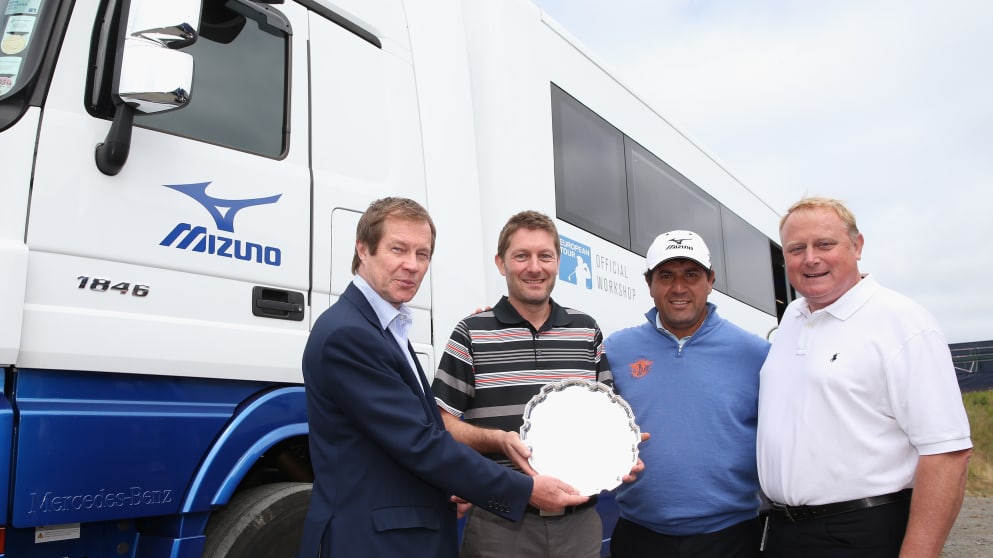For 16 years Andy Kikidas has been an ever present on the practice ranges across Europe heading up the Mizuno team on The European Tour’s Official Workshop but The Open Championship marks his final appearance before retirement.

Kikidas, who has been with Mizuno for 17 years in total, has travelled thousands of miles with the European Tour in providing a complete equipment service to all players on Tour, regardless of their personal sponsorships and equipment affiliations.
The Mizuno Official European Tour workshop has serviced the clubs of the European Tour’s professionals since 1986. A vision of European Tour Chairman Neil Coles to provide the Tour with a mobile factory, the Mizuno workshop heralded a new level of professionalism on The European Tour, and the reputation and value seen by all the players led to the Official Workshop status being extended in 2005 for an additional 20 year period, up to 2024. This is the longest single running agreement any company has had with the European Tour which speaks volumes for the level of service and commitment Mizuno has given to the Tour.
The project started in 1984 when Coles and St. Georges Hill clubmaker, Barry Willett set up a temporary workshop at The Open in St. Andrews. That proved such a success that soon Mizuno were on board and within two years the Mizuno workshop was a fixture at some 25 events each season.
The latest Workshop – the third vehicle since 1986 – is a state of the art facility with every tool and device required to carry out full build, adjustment and fitting of golf club equipment to ensure the players are getting the most from their equipment.
“The whole service was a bit of an experiment,” said Kikidas, who took over when Willett retired in 1998. “It hadn’t been done before and nobody really knew how it would work. But for the players, a big part in improving their game and getting the best out of their ability was how to make the most of their equipment.
“When we started we had two or three different shafts and now there are hundreds. The skills have changed with the equipment and now it is more of a case of fitting rather than building as we used to with the old persimmon woods. It’s a case of working with players and coaches to try to combine what they are doing with their swings with how their equipment fits into that.
“The guys at this level notice every small change, they are so consistent that every ½ inch here or 1/8 of an inch there can make a massive difference. Everything has to be set up perfectly and we now have machines to measure everything. It’s a huge factor in getting the players to play their best golf.”
To keep the players serviced a huge amount of stock is carried, including 3500 shafts, 7000 grips, and 100 sets of iron heads plus woods, hybrids and wedges. Additionally all the soft goods are catered for, just in case an airline decides a player’s equipment doesn’t turn up at the same time as him!
The majority of work undertaken by Mizuno’s team is maintenance based with time spent checking the players loft and lies and replacing worn grips. The workshop also provides a platform to promote Mizuno products to Europe’s leading professionals, whilst being a key link in the R&D process. Data is collected through the use of a Trackman launch monitor system which also provides an excellent way of fitting the best specifications for each individual swing. Equipment tastes and trends are fed back to Mizuno’s R&D centre through its Japanese technicians, whilst new prototypes have a platform to be tested by some of the best players in the World.
“The biggest change has been with the drivers,” reflected Kikidas. “The heads are far more forgiving. It’s a power game now – hit is hard and ling and then tweak it to get consistency. Hybrids have also helped a lot in getting the ball out there 220 to 230 yards and landing softly.
“But is has been the launch monitors which have really helped us. We now collect so much data with each swing you can really notice performance differences. Before we would simply go out and watch the ball flight but now it is all on computer with the data to back it up. As a result the quality is much more consistent.”
Now it is time to down tools and no more airports and hotels, no more building and fitting clubs, or even mending a broken snooker cue as once requested by a caddie!
“I’ll miss the people out there,” admitted Kikidas, who was presented with a commemorative plague by European Tour Chief Executive George O’Grady during the Aberdeen Asset Management Scottish Open in his final week on Tour. “The banter and camaraderie is fantastic. I have met some fantastic people and everyone wants to help each other out. But I won’t miss the airports!”






